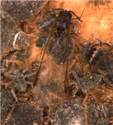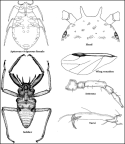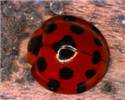Classification
Hormaphidinae: Cerataphidini
Common name(s)
Bamboo aphid
Diagnosis
The aphid is dark olive green to grey with profuse wax secretion confined to posterior region and the rest of the body is lightly dusted with wax. Antennae dark brown, 4- or 5-segmented in apterae, in alatae always 5-segmented, at most 0.50 x body, sparsely imbricated; p.t. at most 0.50 x base of last antennal segment. Rostrum extends up to midcoxae; u.r.s. bluntish, at most 0.75 x h.t.2 and without any secondary hair.0.12-0.15 times as long as body. Processus terminalis shorter than base, 0.55 times as long as base of last antennal segment. Siphunculi pore like, cauda rounded with 14-20 hairs. Soldier caste often seen in large numbers in the colony, readily recognised by the much longer legs and the prominent frontal hairs.
The infestation starts at the terminal portion and later spreads on the internodes. It sticks to the plants firmly and is released only with difficulty. It produces lots of honeydew, which falls in the form of drops on the ground and sooty mould is seen even on the ground at the basal portion of the plants. This is the major species of aphid occurring on bamboo. It also causes visible damage on shoots making them colourless.
Distribution
India (Arunachal Pradesh, Manipur, Karnataka, Sikkim, Tamil Nadu, West Bengal), Japan, Taiwan, Vietnam, Australia, New Zealand, Puerto Rico, Cuba.
Host plant(s)
Poaceae: Bambusa arundinacea Willd.
Measurements
Aptera: Length of body 3.01, width 2.13; antennae 0.45, segments III: IV:V: 0.18: 0.09: (0.09+0.05); u.r.s. 0.13; h.t.2 0.24.
Alata: Length of body 2.76, width 1.32; antennae 0.98, segments III: IV: V: 0.53: 0.24: (0.14+0.03); u.r.s. 0.10; h.t.2 0.19.
Seasonal occurrence
June-August and January-February.
Natural enemies
Coleoptera: Coccinellidae: Anisolemnia dilatata (F.), Synonycha grandis (Thunberg), Scymnus sp.
Note
*Identity of this species needs to be confirmed











